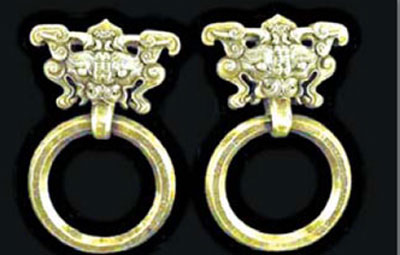More than 60 top-quality folk art pieces will be up for grabs during the 2007 Hanhai autumn auctions running from December 15-17 at the Kerry Center Hotel in Beijing.
Created by 40 top Chinese folk artists, the works to go under the hammer include zisha (purple-clay) teapots, porcelain, jade carvings, red sandalwood furniture, ink slabs, lacquer works, kesi weaving (weaving done with fine silks and gold thread according to the tapestry method) and traditional Chinese musical instruments such as guqin, organizers say.
Highlights also include ancient works from top Ming (1368-1644) and Qing (1644-1911) dynasty craftsmen, such as ancient bronze sculptures featuring Tibetan Buddhist gods and deities, ink paintings by modern masters, such as Qi Baishi and Xu Beihong, experimental art by Japanese and South Korean artists, and oil works by Luo Zhongli, He Duoling, Cheng Conglin and Zhang Xiaogang, who studied at the Sichuan Academy of Fine Arts.
Auction of knockers causes controversy
A pair of knockers from Yuanmingyuan, the imperial summer resort that was sacked and destroyed in 1860 by British and French forces, was auctioned in Beijing on Sunday despite opposition from experts.
The silver knockers were sold off by Beijing Rongbao Auction Ltd for 1.9 million yuan ($257,050), with a 228,000 yuan commission.
Experts said the knockers were rare, as the imperial family commissioned them in the 1700s to be made in the design of a taotie, a ferocious mythical animal that was popular in the Western Zhou Dynasty (1100 BC-771 BC).
They are believed to have been specially made for Yuanmingyuan. The summer resort was the largest imperial garden in the Qing Dynasty (1644-1911).
An expert from the Yuanmingyuan Society said the organization objected to the auction of Yuanmingyuan antiques taken by foreign countries, believing it would hinder efforts to return the antiques to the imperial garden.
Yuanmingyuan spokesman Zong Tianliang said: "The knockers were of historic value; and it is good for them to return to where they were, rather than putting them under the hammer."
However, the company said authorities approved the auction, and they had not received official objections from the Yuanmingyuan administration office.
Located in northwestern Beijing, construction on Yuanmingyuan began in 1709 and was finished in 1744. It was burned down by British and French troops in 1860.
It was sacked and burned down again, after a partial restoration, in 1900, when the Eight-Power Allied Forces - troops sent by Britain, the United States, Germany, France, Tsarist Russia, Japan, Italy and Austria - occupied Beijing.
(China Daily/Xinhua December 11, 2007)



